15 Physical Therapy Shoulder Exercises With Resistance Bands

In this post I want to show you how to do physical therapy shoulder exercises with a resistance band to strengthen, rehabilitate and injury-proof your shoulders.
My shoulders have taken a beating over the years.
Rugby, jujitsu, weightlifting, boxing – all have taken their toll.
One rotator cuff operation and countless physiotherapy shoulder exercises later, I’m pretty much OK. Just that there are a lot of things I know I can’t do anymore (rugger and jujitsu are definitely out).
Shoulders are like knees and backs. They’re complex joints which can take a hammering when you play sports, so they injure easily. Anyone who’s highly active will be lucky to get through life without at least one shoulder, knee or back injury.

Looking back, I wish I’d done more physical therapy shoulder exercises BEFORE I got injured. Prevention over cure, any day. Problem is, when you’re young, strong and filled with the thrusting energy of youth, the last thing you think about is injury prevention.
Well, I’m not as young as I was but my plan is to stay active for many decades to come. I’m of the school that believes the body should age like good wine. The secret is to train every day. But train in the right way.
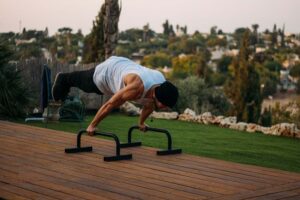
So I do a lot of exercises now which will keep me doing what I enjoy doing when I’m well into my 80s. I do yoga to stay flexible, I work a lot on my core stability. And I use physio resistance bands to strengthen my shoulders and other easy-to-injure joints.
Physical therapy resistance bands are perfect for joint strengthening exercises because they can apply resistance from any angle (unlike free weights, which depend on gravity). This is important because you need to add many different degrees of rotation to the rehab exercises, and you can’t do this with weights.
Using resistance bands for physical therapy exercises has an extra advantage. The resistance level of elastics increases as they are stretched. This ascending resistance is beneficial for injury recovery and prevention because it means the joint will receive the highest resistance when it is in its strongest position.
Whether you’re young or old, fit or injured, my advice to you: look after your joints. Spend an hour a week using resistance bands for physio exercises, and you will thank me in the end!
Table of Contents
TogglePhysical therapy shoulder exercises
 Here I want to share with you 15 physio shoulder exercises, which are done with a physical therapy resistance band (pictured). These exercises are designed to strengthen and injury-proof your shoulders, as well as help with rehabilitation and mobility.
Here I want to share with you 15 physio shoulder exercises, which are done with a physical therapy resistance band (pictured). These exercises are designed to strengthen and injury-proof your shoulders, as well as help with rehabilitation and mobility.
If you have an existing injury, be sure to consult a physiotherapist, as every injury is unique and some of these exercises may not be suitable for you.
Here are my 15 best physical therapy shoulder exercises using a resistance band:
#1 Outward Shoulder Rotator

Hold the band with forearms extended in front of you, elbows in to your sides. Stretch the band by rotating your shoulders outward, keeping your forearms horizontal. Make sure to keep your shoulders in a natural position – not hunched up or forward.
#2 Bent Over Row

Stand on the centre of the band and hold onto either end. Bend your knees and lean forward, keeping your back straight. Pull the band taut, squeeze your shoulder blades together and hold for a moment.
#3 Front Raise
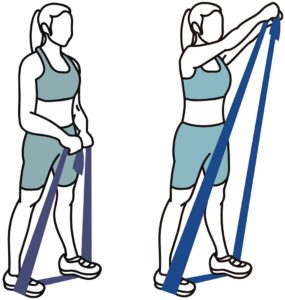
Stand on the centre of the band, feet shoulder-width apart. Holding onto the ends, lift your arms straight in front of you up towards the ceiling. Do not shrug your shoulders during the movement.
#4 Diagonal Shoulder Flexion

Secure the band below waist level and hold one end with your elbow straight, hand at the opposite hip. Pull the band upward and away from your body, keeping your arm straight. Maintain an upright posture throughout.
#5 External Shoulder Rotation

Secure the band to an object at chest level and hold one end with the band taut. Keep your elbow close to your side (can place a rolled towel between your body and upper arm to limit upper arm movement). Rotating your shoulder outwards, stretch the band as far as possible. Be sure to keep your shoulder back and your elbow in.
#6 Internal Shoulder Rotation
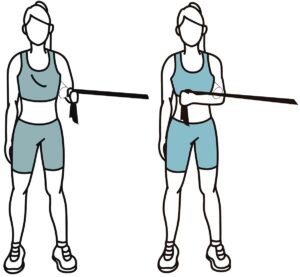
Same as above, except this time you are rotating your shoulder inwards. Again, be sure to keep your shoulder back (not hunched forward) and your elbow close to your side. Placing a towel between your body and upper arm may help.
#7 Horizontal Arm Extension

Hold the band with arms horizontally out in front of you. Keep your elbows unlocked and your posture upright. Pull the band apart as far as possible and hold for a moment, squeezing your shoulder blades together.
#8 Kneeling Row

Start in a half kneeling position with the band around your front foot. Hold the band and lean forward over your front leg. Keep your back straight and pull back without shrugging your shoulders.
#9 Lat Pulldown
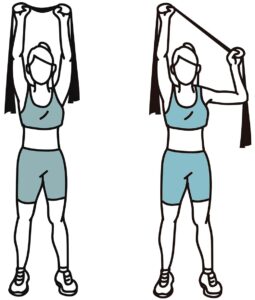
Hold the band at arms-length over your head. Keep one arm straight and braced firmly. With the other arm, pull the band downwards and outwards to head-height then return to start and switch arms.
#10 Lateral Raise
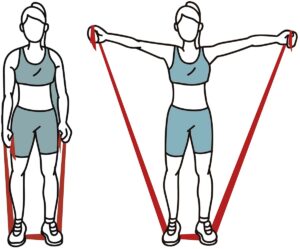
Stand on the centre of the band, holding on to either end. Keeping your body and arms straight, lift your arms out to the side until they are at head height.
#11 Overhead Row

Hold the band with arms extended over your head. Slowly lower your elbows, stretching the band apart behind your head. Squeeze your shoulder blades together and maintain an upright posture.
#12 Rear Arm Extension

Hold the band with your arms behind your back, elbows unlocked. Pull the band apart, keeping an upright posture.
#13 Resisted Push Up

Loop the band behind your back. Get into a push-up position, holding the band under your palms. Perform push-ups as normal.
#14 Seated Row

Sit on the floor with your legs straight out in front of you. Loop the band around your toes and grasp the other ends with both hands. Keeping your back straight, pull the band towards your chest and hold briefly.
#15 Vertical Arm Extension

Hold the band with arms extended straight in front of you, one higher than the other. Pull the band apart, moving the arms in a vertical plane.
 These physio shoulder exercises are great for strengthening your shoulders and reducing the chance of injury. For initial recovery after shoulder surgery, a physiotherapy shoulder pulley is often the best solution. Once you have gained a degree of mobility in the shoulder socket with the pulley, you can start using resistance bands for physio exercises to build up strength and greater mobility in your shoulder. See this article for how to use a shoulder pulley for physical therapy exercises.
These physio shoulder exercises are great for strengthening your shoulders and reducing the chance of injury. For initial recovery after shoulder surgery, a physiotherapy shoulder pulley is often the best solution. Once you have gained a degree of mobility in the shoulder socket with the pulley, you can start using resistance bands for physio exercises to build up strength and greater mobility in your shoulder. See this article for how to use a shoulder pulley for physical therapy exercises.
Follow our Instagram and YouTube channels for exercise videos like this shoulder workout:


